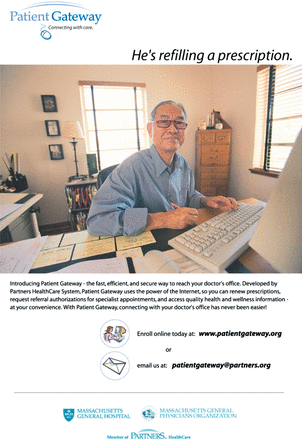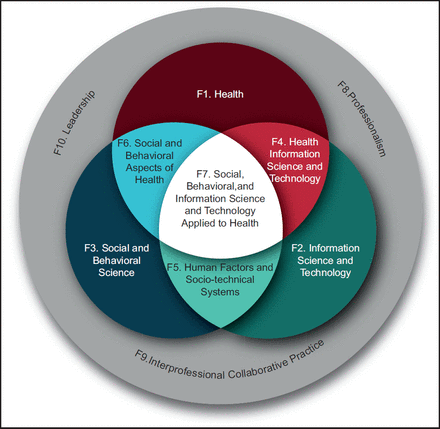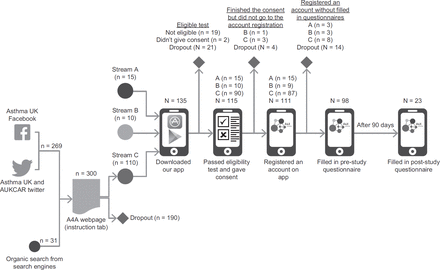Abstract
Background Patient portals have emerged as an important tool through which patients can access online health information and engage in their health care. However, we know little about how patients perceive portals and whether patient perceptions might influence portal adoption.
Objective Apply the diffusion of innovation (DOI) theory to assess perceptions of adopters and non-adopters of a patient portal.
Methods We conducted a cross-sectional survey of adopters and non-adopters of the portal. Our survey consisted of perceived attributes from the DOI theory, socio-demographic characteristics and patient perceptions of technology adoption.
Results Three factors representing perceived attributes from DOI theory accounted for 73% of the variance in the data: Factor 1 – Relative Advantage (27%); Factor 2 – Ease of Use (24%) and Factor 3 – Trialability (22%). Adopters perceived greater Relative Advantage [mean (SD)] = 3.8 (0.71) versus 3.2 (0.89), p < 0.001, Ease of Use = 4.1 (0.71) versus 3.3 (0.95), p < 0.001 and Trialability = 4.0 (0.57) versus 3.4 (0.99), p < 0.001 than non-adopters. In multivariate modelling, age [OR = 3.75, 95% CI: (2.17, 6.46), p < 0.001] and income [OR = 1.87, 95% CI: (1.17, 3.00), p < 0.01] predicted adoption of the portal. Among DOI factors, Relative advantage predicted adoption of the portal [OR = 1.48, 95% CI: (1.03, 2.11), p < 0.05].
Conclusion Patients will adopt a patient portal if they perceive it to offer a relative advantage over existing practices such as telephoning or visiting the doctor’s office. Organisations seeking to increase the adoption of patient portals should implement strategies to promote the relative advantage of portals as, for example, through posters in waiting and exam rooms. A digital divide in the adoption of patient portals may exist with respect to age and income.
BACKGROUND
A patient portal is a tool tethered to an electronic health record (EHR) through which patients have access to the information in their provider’s EHR, such as the problem list, medication list and test results.1,2 Patient portals also allow patients to request appointments, refill medications and communicate with their care team about non-urgent medical issues. Over the past decades, patient portals have emerged as an important tool through which patients can access online health information and engage in their healthcare.3–12 As a result, there has been a considerable interest in the adoption of patient portals in general and more specifically in the characteristics of patients who adopt (or do not adopt) a patient portal.
Both qualitative and quantitative studies have emerged on the adoption of patient portals. In a qualitative study, Ryan et al.13 identified ease of use of the patient portal as a necessary condition for its adoption. Nguyen et al.14 identified the perceived advantage of the patient portal, specifically the ability to be able to access the EHR anywhere, as an important factor in portal adoption. Quantitative studies have focused on rates of portal adoption and characteristics of patients who have adopted portals. A survey in the state of New York found a 50% increase in whether patients had ever used a portal from 11% in 2012 to 20% in 2013.7 Neuner et al.8 found that the patient enrolment in a patient portal increased from 13.2% in 2010 to 23.1% in 2012. The same study found that patients in the age group 50–65 years were more likely to adopt a portal than patients in other age groups. In a study of portal adoption, we found Caucasian patients and patients with higher income were more likely to adopt the portal.15 In a study of the patient portal use, we found users of a portal were more educated and had a higher income than non-adopters of the portal.16
Beyond the patient characteristics, it is important to assess patient perceptions of the patient portal since the portal is in part an innovation adopted by the patient to partially replace the existing practice of telephoning or visiting the doctor’s office. For example, do patients adopt a portal because they perceive it to be easy to use, whereas non-adopters perceive a portal to be complicated and difficult to use? As Rogers17 concluded in his influential diffusion of innovation (DOI) theory, it is perceptions of the innovation rather than its actual attributes that influence adoption. In his theory, Rogers identified five perceptions, or perceived attributes, that are most likely to influence the adoption of an innovation: (1) Relative Advantage, or the degree to which an innovation (such as a patient portal) is perceived as being better than the idea it supersedes (e.g. telephoning the doctor’s office); (2) Compatibility, or the degree to which an innovation is perceived as consistent with existent values, past experiences and needs of potential adopters (as, e.g. past experience with using the Internet); (3) Complexity, or the degree to which an innovation is perceived as easy to understand and use as a whole or in incremental parts; (4) Trialability, or the degree to which an innovation can be experimented with on a limited basis (e.g. trying a patient portal for tasks such as appointment requests or secure messaging) and (5) Observability, or the degree to which the benefits of an innovation are visible to intended adopters. Rogers has provided an extensive summary of the literature showing that each of these five perceived attributes is positively related to the rate of adoption of an innovation.
OBJECTIVE
In this study, we apply Rogers’ DOI theory to assess and compare perceptions of adopters and non-adopters of a patient portal.
DISCUSSION
We applied DOI theory to assess and compare the patient perceptions of adopters versus and non-adopters of a patient portal and found three factors representing DOI theory: Relative Advantage, Ease of Use and Trialability. Furthermore, adopters of the patient portal perceived greater Relative Advantage, Ease of Use and Trialability than non-adopters. Of the three factors, Relative Advantage emerged as the top factor followed by Ease of Use and Trialability. In our previous study that applied DOI theory to assess perceptions of users of a patient portal, Ease of Use had emerged as the top factor followed by Relative Advantage.16 It is possible that as adopters start using patient portals, their perceptions shift from the portal providing a relative advantage to that of the portal being easy to use. Greenhalgh et al.21 pointed to the possibility that perceptions may not be stable and, instead, could change over time. Additionally, research on information systems use based on expectation-confirmation theory has examined the role that changes in perceptions and beliefs can play in the continued use of the systems.22,23 For example, the initial perception of Relative Advantage can be disconfirmed upon the use of the portal resulting in a modified and negative perception of Relative Advantage which could then impact the continued use of the portal. Longitudinal studies of perceptions of patient portals are needed to better understand changes in perceptions about patient portals and their impact on portal usage.
As in our previous study, Compatibility did not emerge as a distinct factor. Other studies have also failed to distinguish between Compatibility and perceived domains of DOI theory such as Relative Advantage.24,25 It is possible that it is simply not possible to discriminate between Compatibility and other perceived attributes in this patient population. The more likely explanation, as suggested by Karahanna et al.,26 is that the construct of Compatibility as defined in DOI theory focuses on needs which are a sub-dimension of Relative Advantage. This logic could explain why Compatibility loaded onto other domains and did not emerge as a separate domain in our factor analysis. To better capture the construct of Compatibility, Karahanna et al.26 proposed a new conceptualisation of Compatibility based on four distinct constructs: preferred work style, existing work practices, prior experience and values. Future studies that apply DOI theory to the adoption of patient portals should focus on one or more of these constructs to assess whether Compatibility emerges as a distinct domain that predicts adoption of the patient portal.
Our multivariate model identified three variables to be significant predictors of adoption: (1) patients less than 65 years of age were 3.75 times more likely to adopt the patient portal; (2) patients who had an annual income greater than $75,000 were 1.87 more likely to adopt the patient portal and (3) Relative Advantage of the portal was perceived to be 1.48 times greater by adopters than non-adopters. In a previous study of our patient portal, we found income was associated with adoption of the portal but not age.15 Neuner et al.8 found that patients in the age group of 50–65 years were more likely to enrol in a portal than patients in other age groups. The patients who were younger and wealthier were the ones most likely to adopt an important issue, as the patients who might be expected to benefit the most would be those who are sicker and less well-off financially.
The significance of Relative Advantage makes intuitive sense as patients will adopt the patient portal if they perceive it to offer an advantage over existing practices such as telephoning or visiting the office. Another relative advantage offered by patient portals is the ability to access the EHR anywhere.14 While this is one of the first studies to apply DOI theory to patient portal adoption, other studies have applied theoretical models with constructs similar to Relative Advantage to predict portal adoption. Noblin et al.27 found perceived usefulness [a construct from the technology adoption model (TAM) which is similar to Relative Advantage] predicted intention to adopt a patient portal. Silvestre et al.3 applied the TAM model and found that perceived usefulness predicted the use of a portal site. Tavares and Oliveira28 applied the concept of performance expectancy (similar to Relative Advantage) and found that it predicted behavioural intention to use the portal. Further studies are needed but we believe that the construct of Relative Advantage plays a particularly important role in the adoption of a patient portal. Relative Advantage may also be particularly amenable to intervention by practices.
CONCLUSIONS
We found the DOI theory to be a good fit for the study of the adoption of patient portals. Three factors from the theory emerged that distinguished adopters from non-adopters: Relative Advantage, Ease of Use and Trialability. In places such as the UK one of the biggest issues that patients have is contacting their practice efficiently, so patient portal implementation might be especially helpful there. Furthermore, demonstrating the relative advantage of a patient portal is likely to be a key factor in efforts to increase the uptake of adoption of patient portals. For example, posters in waiting and exam rooms can highlight the relative advantage of patient portals for tasks like appointment requests, medication refill requests and asking the care team a non-urgent medical question. In Appendix 2, we provide an example of a poster demonstrating Relative Advantage of prescription refills via the patient portal.
Beyond the DOI theory, we continue to find a digital divide in the adoption of patient portals with respect to age and income. At the same time, health systems may be especially interested in getting older and sicker patients to adopt patient portals. As such, there may need extra efforts aimed to demonstrate the relative advantage of portals to such groups. We also found adopters had greater personal innovativeness in the domain of information technology (PIIT) than non-adopters and the findings were remarkably similar to our previous study. This raises the concern whether PIIT is a characteristic of the digital divide in the adoption of patient portals. So far, efforts to understand the digital divide in patient portals have focused on socio-demographic characteristics, access to technology and health literacy. Further studies should explore whether PIIT is also a characteristic of this digital divide and its implications for adoption and use of patient portals.
Finally, this study contributed to the existing literature through the application of a theoretical framework, the DOI theory, to the study of patient portals. The application of theoretical models in the patient portal research has been lacking as we have pointed out in our previous studies.12,16 The relevance of a theoretical model such as DOI extends beyond the study of perceived attributes such as Relative Advantage and Ease of Use. Through the DOI model, Rogers17 has cautioned about the positivist bias in adoption research and the need to understand how and why innovations may be rejected. We believe that this also applies to patient portal adoption and use. We need to better understand rejection and discontinuance in the context of patient portals.21,23 We also encourage the application of DOI theory in the patient portal research in other social and cultural contexts. Most of the reported research on patient portals is from North America. Portal developers, researchers and practitioners would benefit from learning experiences and findings of other social and cultural contexts.
LIMITATIONS
This study has several limitations. It was conducted in only one system and one region, and the results may not be generalizable to other settings. Our concept of Compatibility in DOI theory focused on compatibility with needs. A different concept, such as compatibility with prior experience with computers and the Internet, may be a better fit for the application of DOI theory to the patient portal research. Other predictors that may play a role in the adoption of the patient portal which were not included in this study include self-efficacy and health literacy. Finally, we only included one component of the DOI theory, perceived attributes, in this study. Rogers discusses other components in the theory such as the role of change agents which can be considered in patient portal research. Change agents with respect to patient portals include physicians and practices that are interested in increasing the adoption of the portal. For example, patient perceptions of patient portals may be influenced by the marketing activities adopted by practices.29
APPENDIX 1: ITEMS ON DOI ATTRIBUTES, PIIT AND PERCEPTIONS OF PRIVACY AND SECURITY
-
Using Patient Gateway will enable me to contact my doctor’s office more quickly (RAb).
-
Using Patient Gateway will improve the quality of care I receive (RA).
-
Using Patient Gateway will enable me to contact my doctor’s office more easily (RA).
-
The effectiveness of care I receive will not improve by using my Patient Gateway (RA).
-
Using Patient Gateway will give me greater control over my care (RA).
-
Using Patient Gateway will fit in with all aspects of my health care coordination (Comp).
-
Using Patient Gateway will fit into my personal and work life (Comp).
-
I think that using Patient Gateway will not fit well with the way I like to receive care (Comp).
-
Using Patient Gateway will require a lot of mental effort (EU).
-
Learning to use Patient Gateway will be easy for me (EU).
-
Using Patient Gateway will be frustrating (EU).
-
Overall, I believe that Patient Gateway will be easy to use (EU).
-
I will try Patient Gateway on a trial basis to see what it can do for me (Trial).
-
I will not lose much by trying Patient Gateway, even if I do not like it (Trial).
-
I will have adequate opportunities to try Patient Gateway to see what it can do (Trial).
-
If I heard about a new information technology, I would look for ways to experiment with it (PIIT).
-
Among my peers, I am usually the first to try out new information technologies (PIIT).
-
In general, I am hesitant to try out new information technologies (PIIT).
-
I like to experiment with new information technologies (PIIT).
-
The identity of anyone using Patient Gateway will be carefully confirmed by my doctor’s office to prevent any unauthorised access or any cases of mistaken identity (Privacy/Security).
-
The information in my Patient Gateway account will only be seen by my health care providers and not by others who are not authorised to see the information such as employers and insurance companies (Privacy/Security).
-
My doctor’s office will immediately notify me if there is a privacy or security breach related to the information in my Patient Gateway account (Privacy/Security).
aAll items rated on the following scale: Strongly Disagree, Disagree, Neutral, Agree, Strongly Agree.
bRA = Relative Advantage; Comp = Compatibility; EU = Ease of Use; Trial = Trialability; PIIT = Personal Innovativeness in the domain of information technology.





